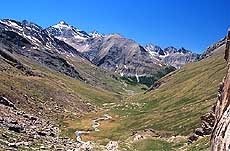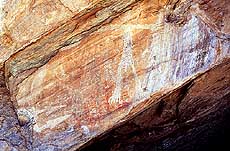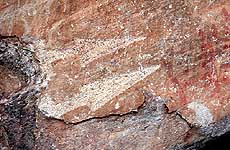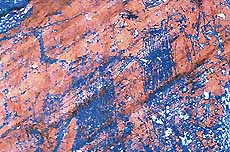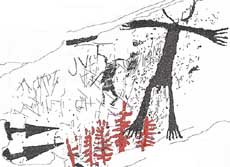|
|
 |
 |
Country: |
France |
Locality: |
Ubaye valley, St. Paul - see original record (ask compiler - institution) |
|
 |
Region: |
Hautes Alpes |
Area: |
Haute Vallée de l'Ubaye |
|
 |
 |
|
|
|
|
| |
 |
Environment & Surface |
 |
 |
 |
|
Altitude:
|
2430 m
Open-air
Shelter
Cave
Portable
Megalithic
|
Geography: |
Rocky shelter on a high mountain south-west exposed slope, pasture, over the vegetation limit of the wood, along the way connecting to the Longet pass, joining the Ubaye French Valley to the Italian Valle Varaita. |
Proximity: |
Stone-walls, abandoned stone-walls house |
|
 |
Geology: |
calcschist, marble |
Surface: |
flat, vertical, patinated |
|
Dimensions:
|
Length 7.00 m.
Width 1.50 m.
|
|
 |
 |
|
|
|
|
| |
 |
Art |
 |
 |
 |
Description: |
Engravings
Paintings
Painted engravings
High or low-relief
Sculpture
One of the most important panels of the entire western Alps, with an exceptional chronological range, from Neolithic to Modern period. The red paintings, which could recall some vegetal elements (or deer horns?), are superimposed the by Copper Age daggers.
|
Figures: |
5 red-painted stick with branches, 4 Remedello kind daggers, 1 great anthropomorphic male figure with open arms, 1 scratched warrior with triangular blade spear, various scratchings, a "ILO" writing, 1 scratched vessel, 1 horse, a "1620 or 1627" dating, writings.
|
|
 |
Chronology: |
Palaeolithic
Epipalaeolithic - Mesolithic
Neolithic
Copper Age
Bronze Age
Iron Age
Roman
Middle Age
Modern
Unknown
The four daggers with half-moon shaped handle clearly recall the Remedello kind ones of Valcamonica (2700-2400 BC). As the red paintings are overlapped by the daggers, they are probably Neolithic. The great anthropomorphic figure could take part of the same phase of the daggers. The scratched warrior clearly recalls similar Iron Age figures. Writings and other figures start from the middle age till the modern period.
|
Notes: |
The shelter was utilised also in recent times by hunters. The underlying plane bottom of the valley, rich of water, was utilised by shepherds till some decades ago. The Remedellian kind daggers could testify the importance of this mountain way, which evidently connected the French side to the Italian one through the Longet pass already in ancient periods. The "crowding" of figures of different periods clearly confirm how the site was attended. |
|
 |
 |
|
| |
 |
Bibliography |
 |
|
|
|
|
| |
 |
Conservation |
 |
 |
 |
Status: |
Public
Private
Park
Classified site
|
Risk: |
On the surface a cast was executed, unfortunately even in the painted part. Traces and drops of synthetic resins covers both the engravings and the paintings. The itinerary is described in a book, and could represent a risk for the integrity of the engravings and of the paintings. The surface is naturally protected from rain and snow. |
|
 |
Conservation: |
Good
Quite good
Mediocre
Bad
|
Intervention: |
The panel has been recorded (International western Alps rock art record), traced (contact tracing in the main part) and photographed (normal light and grazing light colour slides). Digital PhotoShop enhancement of the pictures. |
|
 |
 |
|
|
 |
By |
 |
|
| |
| Record n. 349 / 807 |
No commercial use is allowed. Specific © is mentioned in the captions or owned by each Author or Institution |
|
| |
 |
EuroPreArt, European Prehistoric Art, is a web-based archaeological project funded by the European Union which aims to establish a lasting data-base of European prehistoric art documentation, to launch the base of an European institutional network and to contribute to the awareness of the diversity and richness of European Prehistoric Art.
It is proposed by: Instituto Politécnico de Tomar (IPT, Portugal),
CUEBC - European University Centre for Cultural Heritage (Italy - Europe),
Consejo Superior de Investigaciones Científicas (España),
Asociación Cultural Colectivo Barbaón (España),
Université de Liège (Belgique),
Gotland University College (Sverige),
University College Dublin (Eire),
Cooperativa Archeologica Le Orme dell'Uomo (Italia),
Study Centre and Museum of Prehistoric Art of
Pinerolo (Italia),
The European Centre for Prehistoric Research in the Alto Ribatejo (Portugal),
ArqueoJovem - a youth NGO (Portugal).
|
|
|
|
 |
|
 NEW: Alpine rock paintings
NEW: Alpine rock paintings